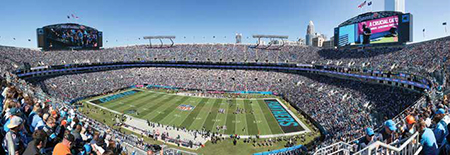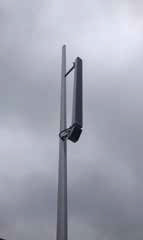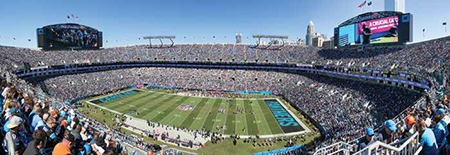The NFL’s Carolina Panthers began a five-year renovation of their Bank of America Stadium in Charlotte, which opened in 1996, during the 2014 offseason. The initial round of upgrades, totaling $65 million, included improvements to the facility’s video capabilities and sound system that were overseen by consultants Wrightson, Johnson, Haddon & Williams, Inc. (WJHW).

Meyer Sound CAL speakers were installed at the Bank of America Stadium as part of a $65 million upgrade. This first phase of upgrades was focused on the upper levels of the stadium, which seats 73,778, and also included construction of new escalators. Because of the amount of AV work that needed to be completed in the timeframe, responsibilities were shared between several companies, according to Mark Graham, associate principal at WJHW’s Denver office. Sound equipment and services provider SE Systems, whose founder and CEO, Cliff Miller, is the stadium’s head of audio, alongside acoustical and audio system design firm James S. Brawley & Associates, Inc., which also has a long history with the venue, worked on the back-of-house audio and end zone sound systems. WJHW designed distributed sound systems plus new 11,000-squarefeet video scoreboards and other displays.
Finding suitable locations to hang a sound system to adequately cover the upper bowl, which seats 36,640, proved challenging, Graham reported. “At each end zone you’ve got the big scoreboard structure, which gives us a good place for long-throw speakers or speakers to cover the upper deck on each end. But they only have four lighting trusses, not quite in each corner.”
With so much real estate to cover between towers, the consultant hit on an alternative solution, installing flagpoles around the upper perimeter of the stadium. A pole with a pair of 12-inch, two-way speakers is normally sufficient, he said, but the distance between poles was greater than such a design could satisfactorily accomplish.
“That’s when we went searching for other options and came up with the concept of using the Meyer Sound CAL speakers, based on working with those guys at Cal Berkeley for the [California Golden] Bears,” he said. Memorial Stadium at UC Berkeley was one of the first installations of the column array loudspeaker, which offers programmable horizontal coverage and vertical beam steering.
Graham’s design comprised 30 CAL 96 loudspeakers, each incorporating 24 four-inch drivers and 72 tweeters, located on evenly spaced flagpoles installed between the lighting towers. The speakers are configured for a 30-degree downward beam tilt and a five-degree vertical beam spread, and the poles tilt forward 10 degrees.

With so much real estate to cover between towers, speakers were installed onto flagpoles around the upper perimeter of the stadium. Graham zoned the lower seating level, covering each similarly-sized area with an EAW QX564i-WP to provide long-throw coverage to the field wall plus two pairs of MK2366i-WP loudspeakers to provide mid-throw or down-fill coverage for the same zone. EAW CIS400 ceiling speakers were installed for the club level seating, lounges, and 158 suites. EAW TT212-WP LF steering woofers positioned one-quarter wavelength behind the QX boxes in an end-fired configuration minimize low-frequency build up in the suites.
EAW QX564i-WP, MK2366i-WP, and MK2364i-WP speakers on the lighting towers provide additional upper-bowl coverage. More QX boxes and JF60zPL-WP speakers positioned on the end zone scoreboards cover the seats below.
Because the flagpoles had to be situated so close to the rear seating final rows, Graham also had a box built to fill the area immediately below each CAL. “I had EAW come up with a small custom cabinet containing a six-inch coaxial with a true compression driver that was roughly the same dimensions as the CAL. The brackets that hold the CAL and the down-fill are an integral part of the flagpole.”
Minneapolis-based Parsons Technologies, a division of Parsons Electric, supplied and installed the Meyer Sound and EAW systems.
The existing QSC Q-Sys DSP platform was also upgraded with Graham’s design: “Cliff [Miller] and Jim [Brawley] worked on updating the back-of-house—the concourse, concessions, and clubs, with the Q-Sys, and we had the Q-Sys that was dedicated to the bowl.” The improvements also added I/O capacity to the existing audio control room, which houses a Yamaha PM5D console, Graham reported.
Four new amplifier rooms, one below each lighting tower, were added during the renovation, offering rack space for the QSC Audio PL3 series amplifiers that power the EAW speakers as well as planned Wi-Fi and cellular service improvements at the stadium. Rather than pull fresh emergency power to the new amp rooms, Graham continued, Miller and Brawley reconfigured the JBL VLA system—two arrays of six VA301H-WRC three-way loudspeakers each and two arrays of six VLA601HWRC three-way speakers each—that they installed about six years ago. “The JBL scoreboard line array system is used now for emergency evacuation and messaging,” said Graham.
Video display upgrades included the replacement of the previous scoreboards with two Daktronics LED HD video boards, measuring 199 feet by 56 feet. Two 360-degree Daktronics ribbon displays, approximately five feet high, were also installed, one measuring 1,900 feet along the upper deck fascia and another, 2,000 feet long, around the club level.
Steve Harvey (sharvey.prosound@gmail.com) has been west coast editor for Pro Sound News since 2000 and also contributes to TV Technology, Pro Audio Review, and other NewBay titles. He has over 30 years of hands-on experience with a wide range of audio production technologies.
